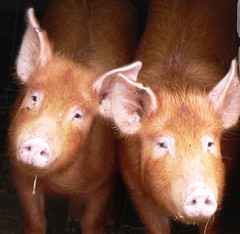Main symptoms of swine flu in humans.[16]
The Centers for Disease Control and Prevention (CDC) reports that the symptoms and transmission of the swine flu from human to human is much like seasonal flu, commonly fever, lethargy, lack of appetite and coughing. Some people with swine flu also have reported runny nose, sore throat, nausea, vomiting and diarrhea.[17] It is believed to be spread between humans through coughing or sneezing of infected people and touching something with the virus on it and then touching their own nose or mouth.[18] The swine flu in humans is most contagious during the first five days of the illness although some people, most commonly children, can remain contagious for up to ten days. Diagnosis can be made by sending a specimen, collected during the first five days, to the CDC for analysis.[19]
The swine flu is susceptible to four drugs licensed in the United States, amantadine, rimantadine, oseltamivir and zanamivir, however, for the 2009 outbreak it is recommended it be treated with oseltamivir and zanamivir.[20] The vaccine for the human seasonal H1N1 flu does not protect against the swine H1N1 flu, even if the virus strains are the same specific variety, as they are antigenically very different.[2
Main article: 2009 swine flu outbreak
Sister project Wikinews has related news: At least 71 deaths in Mexico 'likely linked' to swine flu outbreak
In March and April 2009, more than 1,000 cases of swine flu in humans were detected in Mexico, and more than 80 deaths are suspected to have a connection with the virus. The Mexican fatalities are said to be mainly young adults, a hallmark of pandemic flu.[26] Following a series of reports of isolated cases of swine flu,[27][28] the first announcement of the outbreak in Mexico was documented on April 23, 2009.
The origins of the new Swine Influenza Virus SIV-H1N1 strain remain unknown. One theory is that Asian and European strains traveled to Mexico in migratory birds or in people, then combined with North American strains in Mexican pig factory farms before jumping over to farm workers.[29] The Mexican health agency acknowledged that the original disease vector of the virus may have been flies multiplying in manure lagoons of pig farms near Perote, Veracruz, owned by Granjas Carroll,[30] a subsidiary of Smithfield Foods.[31]
Monday, April 27, 2009
Subscribe to:
Post Comments (Atom)


No comments:
Post a Comment